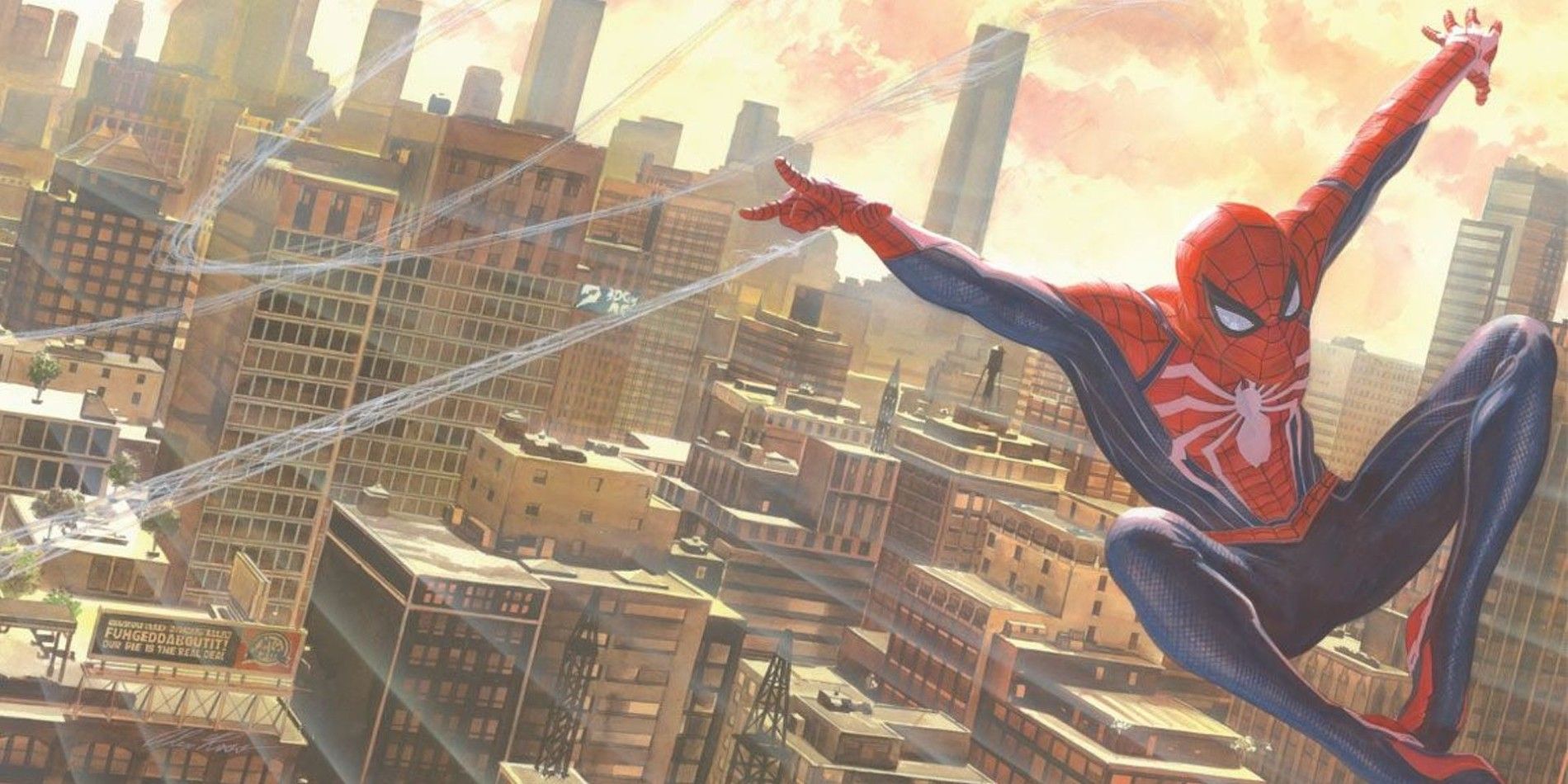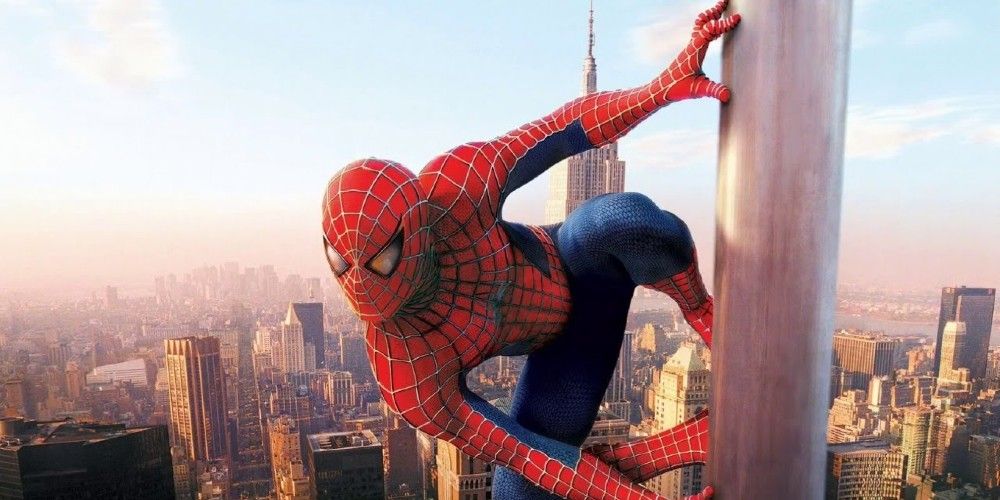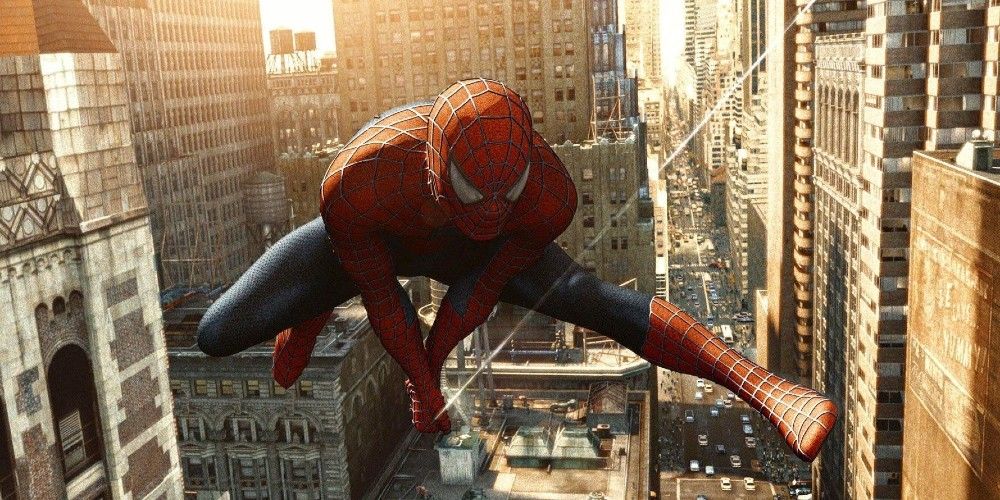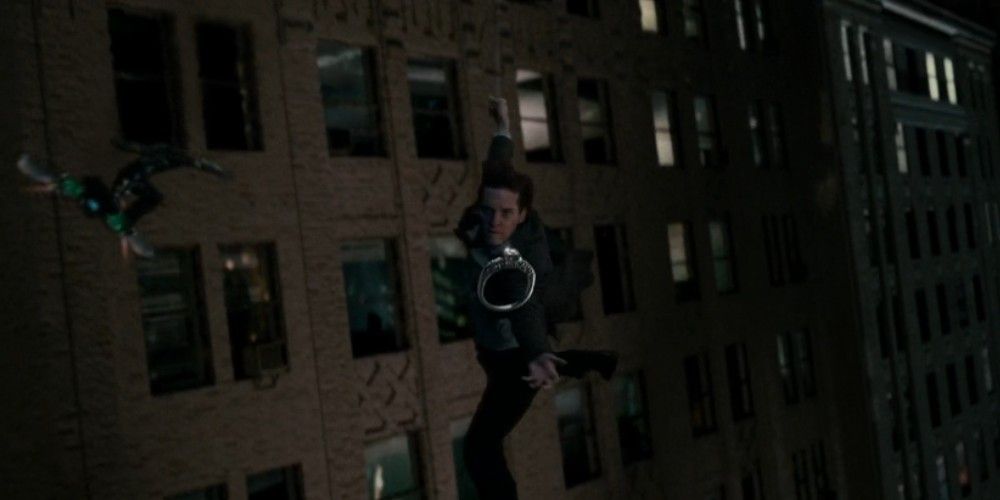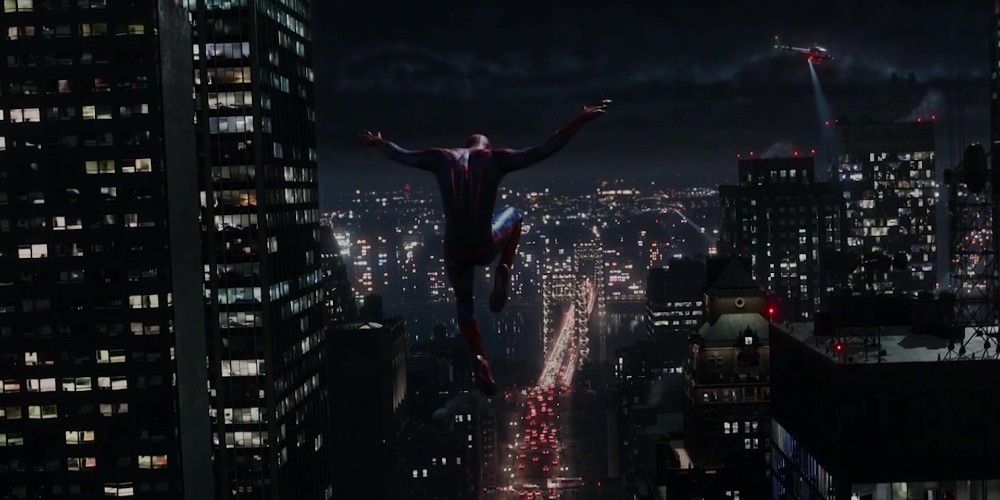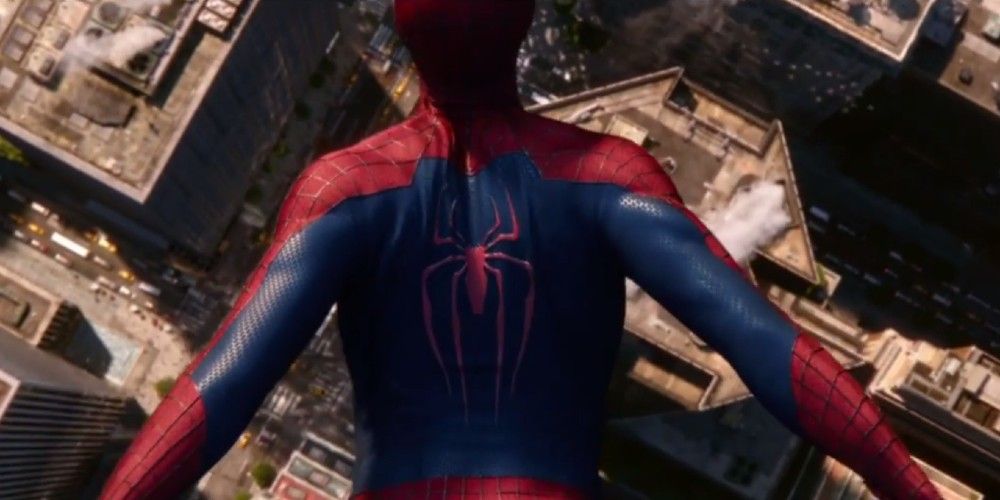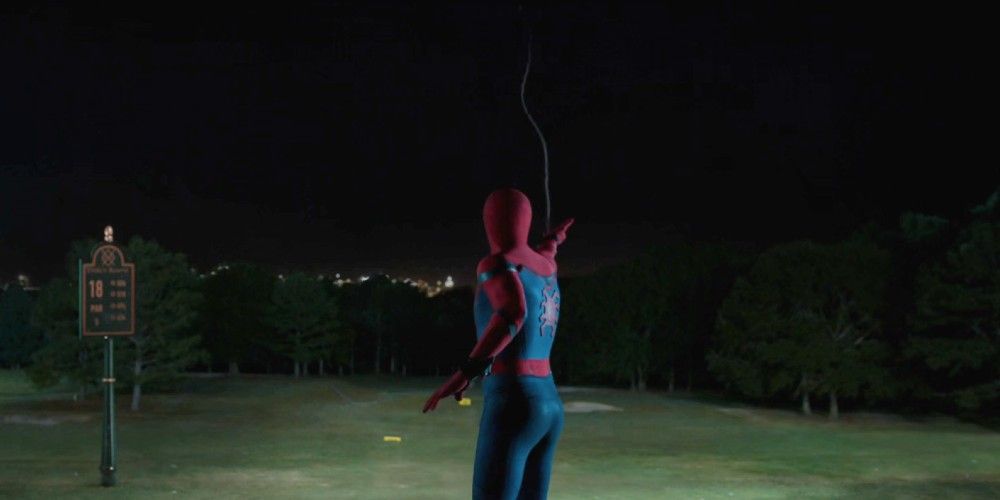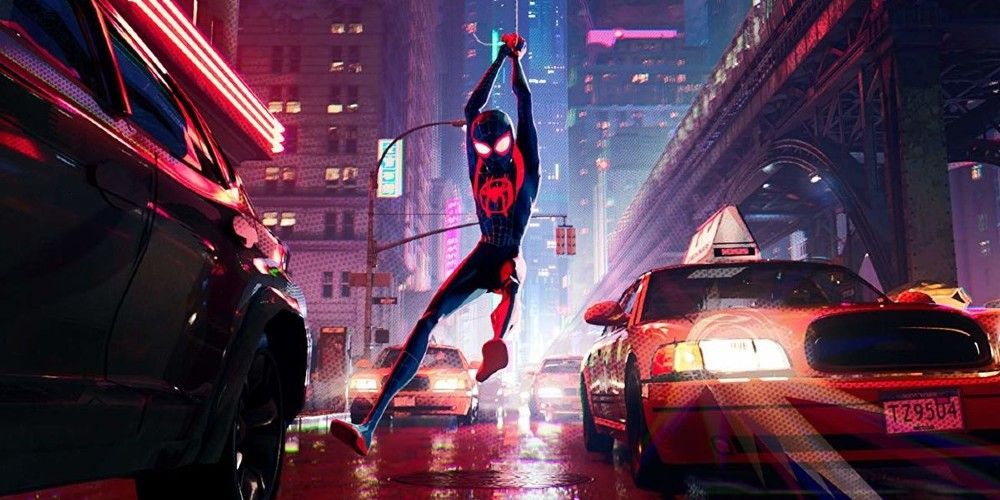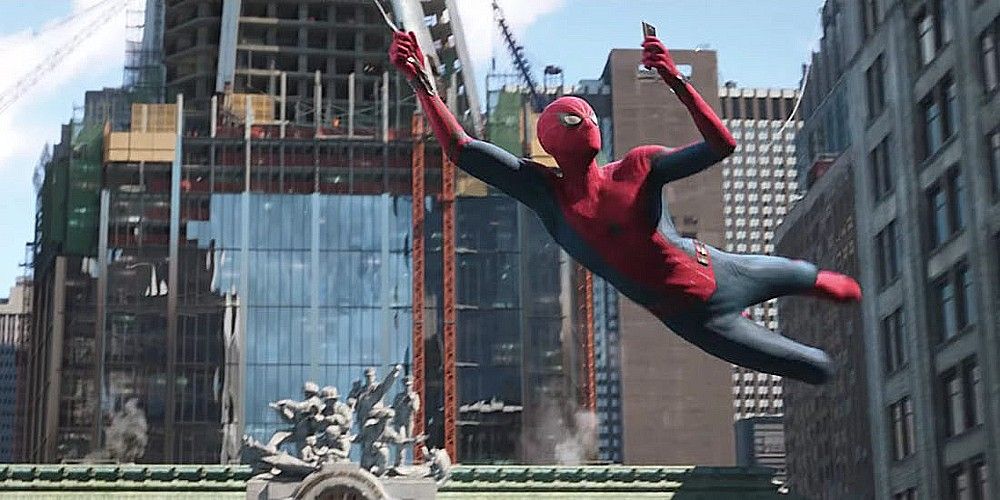Before superheroes can stop crime, they have to get there first. Superman can run faster than a speeding bullet and leap tall buildings in a single bound, although usually he just flies. Wonder Woman has a criminally underused Invisible Jet, Ghost Rider has a motorbike (or car if he is Robbie Reyes), and Batman has a vast collection of Bat-themed vehicles. Spider-Man has a unique mode of transportation: projecting long lines of sticky web-strings to New York’s skyscrapers and leaping between them. As the song goes, “Can he swing from a web? / Take a look overhead”.
Spider-Man’s signature web-slinging makes for a fascinating visual when translated into motion, turning him into the Tarzan of the concrete jungle. It is the primary mechanic in his video-game adaptations. Yet it also requires more ingenuity to adapt into films than simply vehicles or even flight. Most Spider-Man films utilize an (appropriately named) Spydercam, a cable-suspended camera-rig that smoothly moves between buildings, with the Web-Head himself often added in post-production. Examining how such web-slinging is portrayed in all eight cinematic Spider-Man adaptations (not including his appearances in MCU team-up films) demonstrates how Spider-Man is able to go catch thieves just like flies.
Spider-Man (2002)
After years of treatments and negotiation, the first live-action film of Spider-Man was brought to cinemas by Sam Raimi in 2002. Raimi was a huge comic-book fan (evident in works like Crimewave or Darkman) but was used to a certain B-movie practical-effects which had to be readjusted for Spider-Man’s physically impossible web-slinging, although this is still very visible in the concluding grudge-match between Spider-Man (Tobey Maguire) and the Green Goblin (Willem Dafoe). Peter Parker’s first attempt at swinging off a tall building is also shot practically, ending with him slamming into a billboard. However after his Uncle Ben (Cliff Robertson) is killed, Spider-Man has an impressive unbroken sequence where he steadily learns to move between the web-ropes mid-air. The CGI is somewhat outdated now, and the rest of Spider-Man mostly keeps the web-slinging to brief insert shots, but it establishes the flow and acrobatics of Spider-Man in ways previously undoable – especially in the triumphant closing swing.
Spider-Man 2 (2004)
With both Raimi and Peter Parker having settled into the franchise, the acclaimed Spider-Man 2 is more ambitious is most aspects, particularly during the web-slinging. Indeed the film opens on Peter needing to make a speedy pizza delivery and resorting to his web-slinging to do so. Of course, being Spider-Man, he gets distracted by having to save some kids and is ultimately fired for his efforts. Most of Spider-Man 2’s web-slinging is low-angle, with him getting closer and further from the camera-angle during what Raimi termed as Spider-Man’s “ballet in the sky”, accompanied by Danny Elfman’s majestic score. Spider-Man 2 also shows Spider-Man weaving through gaps in truck chassis and entangling on the sides of buildings with Doctor Octopus (Alfred Molina), enabling the film to show the full range of Spider-Man’s dynamic movement. Spider-Man 2 also shows Peter losing his powers, sometimes mid-swing, which only emphasizes how dangerous Spider-Man’s web-slinging really is. But of course when Peter regains his confidence and responsibility of Spider-Man, his return is signaled by swinging out of a Daily Bugle newspaper.
Spider-Man 3 (2007)
The web-slinging is fairly similar in Spider-Man 3, although an early fight between Spider-Man and Harry Osborn’s ‘New Goblin’ (James Franco) does have Peter Parker in civilian clothing battling in mid-air. The unmasked Peter does make the CGI more apparent, but its still an exciting and often brutal sequence. Spider-Man 3’s scenes are overall more ‘aggressive’, with him often swinging directly into the camera, his power having been enhanced by the symbiotic ‘black suit’. Most of the other fight sequences are in fairly contained locations (the sewers or a construction site), but Spider-Man 3 sustains the aerial acrobatics of the web-slinger – even if this is the only Raimi Spider-Man without a ‘final swing’.
The Amazing Spider-Man (2012)
Even with the mixed reactions to Spider-Man 3, Marc Webb’s reboot The Amazing Spider-Man faced a tall order living up to Raimi’s adaptations. Webb’s film shifted from the cheesy pop-art bombast of Raimi’s world to create a ‘darker’ (tonally and aesthetically) and more ‘realistic’ take on Spider-Man (now Andrew Garfield). This includes sticking with the web-shooters comic-book origin of being designed by Peter Parker instead of organic, although whether ‘organic’ or ‘home-made’ webbing is more ‘realistic’ is up for debate. Subsequently, web-slinging scenes were rendered more practical courtesy of stunt coordinator Andy Armstrong.
Peter again develops his web-slinging as part of his power discovery, but now within a skateboard/parkour montage jumping between different chains. When this Spider-Man jumps off a building he shoots his webbing after his leap, with rapid-editing showing him landing on some outdoor tables. For whatever reason, The Amazing Spider-Man tones down the web-slinging, often observing Spider-Man from a distanced landscape shot when he does so, or quickly cutting between his swings – even during a climactic moment of Spider-Man leaping between cranes. Although the film does utilize some interesting first-person POV shots, and the film concludes with a fluid and unedited final swing.
The Amazing Spider-Man 2 (2014)
In a sharp turn from its previous installment, The Amazing Spider-Man 2 prominently features web-slinging in glorious long-takes during the bright day-time. The camera sticks close to Spider-Man, showing his costume rippling in the wind or even attached to his chest like a Go Pro. The benefit of advanced CGI enables these sequences to be fluid while still tactile, following Spider-Man as he bounces off New York’s rooftops. When chasing Electro (Jamie Foxx) through the city, this Spider-Man will often pull himself up his webs (as opposed to simply letting go) and run on the sides of buildings. Although The Amazing Spider-Man 2 has many faults, the web-slinging is not one of them.
Spider-Man: Homecoming (2017)
By the time Spider-Man integrated into the MCU, it was clear how much audiences had seen Spider-Man before. As such, Spider-Man: Homecoming deliberately undermines or subverts when Peter Parker (now Tom Holland) swing around the city. A montage of Spider-Man stopping minor crimes has him leaping out of nowhere without much web-slinging in-between, and it wrings comedy from Spider-Man being stuck in the suburbs without any tall buildings to swing off. Even when he manages to it shows Peter humorously stumbling through people’s backyard in a homage to Ferris Bueller’s Day Off (which Homecoming directly shows on a TV screen). Outside of this sequence there isn’t much web-slinging in Homecoming, perhaps reasoning it had been done before.
Spider-Man: Into the Spider-Verse (2018)
Into the Spider-Verse’s web-slinging would already have an advantage by being animated – as it doesn’t have to shift between practical effects and CGI – but the gorgeous and vibrant cell-shaded animation style adds to the kinetic rhythm. As Into the Spider-Verse shows a ‘new’ Spider-Man in Miles Morales (Shameik Moore) who does not have web-shooters at first (neither organic nor home-made), the web-slinging is somewhat reduced. Although Into the Spider-Verse does subvert the ‘first leap’ of both Spider-Man and The Amazing Spider-Man by Miles rejecting a tall building for a smaller one, and then tripping over his shoelaces.
But therefore Into the Spider-Verse contains the clearest explanation of web-slinging when alternate-dimension Peter B. Parker (now Jake Johnson) teaches him how to “thwip and release”. As with all the action sequences, Into the Spider-Verse has momentum and limitless energy, its animation releasing it from all restrictions of speed or closeness. Additionally, Miles’ own climatic moment is expressed through a dramatic leap-of-faith web-swing set to “What’s Up, Danger”, keeping with tradition but making it his own.
Spider-Man: Far From Home (2019)
Spider-Man: Far from Home is the sole Spider-Man-focused film that takes him out of New York. Away from the reliable skyscrapers, this chapter allows for Peter to creatively swing through old European architecture and monuments, be it in Venice or Prague or London. Most of this web-swinging is contained within his battles against the ‘Elementals’ or Mysterio (Jake Gyllenhaal), since Peter is not ‘patrolling the city’ in Far From Home and actually is trying to avoid getting involved. But the clean and bouncy CGI enables impressive sequences of Spider-Man webbing up buildings and saving people from falling debris. Plus, when he returns home to New York, Spider-Man is given a classic extended web-slinging sequence that he even gets to take M.J. (Zendaya) on. Although after J. Jonah Jameson (J. K. Simmons) reports how Spider-Man has been framed for Mysterio’s death, future Spider-Man films may feature how more intense web-slinging as he evades the cops to clear his name.

